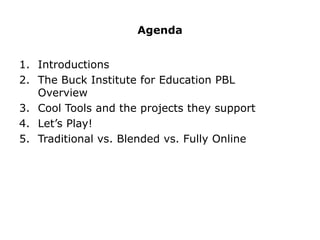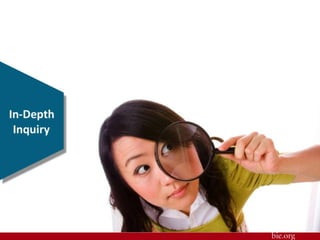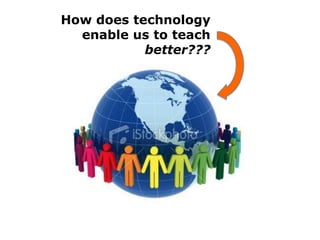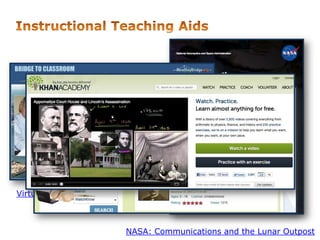Digital Age PBL
- 1. While we wait for the session to begin, PLEASE REGISTER AT: http://www.bie.org/project_planner/create Project Based Learning in a Digital Age
- 2. Project Based Learning in a Digital Age John Mergendoller, Buck Institute for Education Barbara Frey, Connections Education Kerry Rice, Ed. D. , Department of Educational Technology, Boise State University
- 3. Agenda 1. Introductions 2. The Buck Institute for Education PBL Overview 3. Cool Tools and the projects they support 4. Let’s Play! 5. Traditional vs. Blended vs. Fully Online
- 17. PBL Tour the BIE Website
- 18. How does technology enable us to teach better???
- 19. Partnership for 21st Century Skills Essential skills and attributes a well-educated person should have in the 21st century: • Global awareness • Communication and • Digital, information, media collaboration and social literacy • Flexibility and adaptability • Financial, business and • Initiative and self- economical literacy direction • Creativity • Leadership and • Critical thinking and responsibility problem solving • Productivity and accountability
- 20. Technology allows… • Repetition • Resource sharing • Individualization • Collaborative • Pace knowledge • Multiple construction representations • Participatory culture • Metacognition • Learning styles • Motivation • Interests • Level playing field
- 22. Virtual Schoolhouse Bridges Project NASA: Communications and the Lunar Outpost
- 23. Virtual Schoolhouse Get a Grip Project
- 24. More tools… • Resource Sharing • Brainstorming – Google Sites – Bubbl.us – Diigo and Webslides – Kidspiration – Edublog • Project Management – CiteULike – Google Groups – Xtimeline – Google Sites – Trailmeme – Gliffy – Paper.li/Scoop it – Doodle • Games • Writing and Reflection – Centre of the Cell – Voicethread – Earthquake – Glogster – Cruel 2 B Kind – Bitstrips – Stop Disasters! – Google Docs
- 25. Interactive Project Planner http://www.bie.org/project_planner/create 1. Register 2. Search the Project Library 3. Project idea and identify tools for support 4. Fill in the Project Planner 5. Share
- 26. How Does Technology Support PBL Learning Environments? Traditional Blended Virtual Creative Commons license
- 27. PBL Digital Age: Bricks and Mortar
- 28. PBL Digital Age: Blended
- 29. PBL Digital Age: Virtual
- 30. How will your classroom be transformed? John Mergendoller Kerry Rice Buck Institute for Education Department of Educational Technology john@bie.org Boise State University krice@boisestate.edu Barbara Frey Connections Academy bfrey@connectionsacademy.com
Editor's Notes
- John Dewey, the father of progressive education who promoted “learning by doing,” would agree that a project has to be designed well in order to be an effective experience for students. Just doing PBL because it’s “active learning” isn’t good enough.
- To Say:To be effective, a project should be the “main course,” not the dessert.Sometimes we go to schools where teachers say, “oh, we do projects” – but are they really doing Project Based Learning?
- To Say:For example, here’s a dessert project. Remember when you were in elementary school and the teacher asked you make something and called it a “project”? Maybe it was a diorama of dinosaurs, a poster, a model of a volcano… (provide or ask for examples from wherever you are, e.g. the life cycle of the salmon poster in the NW)In California, almost all 4th graders do the “Mission Project.”Typically, the teacher covers the history of the Spanish rule of California, using a combination of lessons, worksheets, books, and videos to teach how they built 21 missions, one day’s ride apart, up the coast from San Diego to Sonoma, to Christianize the Indians and control the land for Spain. Somewhere in the middle of the unit the teacher would assign students the “project” of building a model of a mission. The student picks a mission, gets the materials (or asks parents to buy the kits that are now sold in stores) and builds the model at home, then brings it to the classroom, where it’s put on a shelf for display. (for a fun look at how much this “project” has become standardized, see:"Does Your Child Have a California Mission Project Due Soon?”http://gradeaprojects.com/)
- To Say:A main course project must have these Essential Elements. The project you design in this workshop will need to address these elements.I’ll explain each of these in more detail, using the project we just saw in the video as an example.
- Technology can be the medium for delivering instruction – especially in fully online classrooms. It’s a support in traditional and blended classrooms. And it can be a motivator for learners.
- Why the technology enables us to teach better than we could without the technology:Repetition: Students can re-read, re-listen, re-watch the content on their own as often as desired/needed.Individualization: Students get what they need (and not what they don’t). Time is used wisely. Pace: Students can read faster and go through problems without getting all content if they don’t need it, or they can take longer if they need it. Different method or format: We all benefit from a different style, or changing the method. We get tired of the same thing, and some times we just don’t understand it the way one person explains it or the way the book shows it. When we have the video and online tools to use, sometimes it clicks more. Metacognition: Students become self-disciplined and learn to understand if they have gained mastering and understanding of the material or not. If they have not mastered it, there is no point in moving on. We move from a goal of checking off lessons and moving through (with or without understanding) to a master approach. Motivating: Who doesn’t enjoy using their creativity, interests, and skills to produce with technology and use their technology? Endless options and opportunitiesStudents are less worried about peers online: example of my student David who is very shy and quiet in person, but through virtual sessions he was one of the most talkative students, and I actually had to limit his use of the microphone to allow other students to participate. Brainstorming, reflectionStudent-centered…
- Global SchoolNet's mission is to support 21st century learning and improve academic performance through content driven collaboration. We engage teachers and K-12 students in meaningful project learning exchanges worldwide to develop science, math, literacy and communication skills, foster teamwork, civic responsibility and collaboration, encourage workforce preparedness and create multi-cultural understanding.
- NASA site is an example of the whole package – project ideas, lesson plans, and supporting materials.Virtual schoolhouse bridge project is an example of a project idea – might be supported with the Bridge to Classroom simulation for example – students construct a bridge designed to withstand an earthquake and then get to test out the design under various circumstances. Watchknowlearn – 20,000 hand picked, vetted, organized and categorized videos for K-12 educationSchoolTube
- AggregatorsSccop It
- One common thread of PBL no matter what the environment is that the focus shifts from teaching to learning. Technology rich learning environments are particularly suited to support instructional models like PBLacross different subject areas and lead beyonddomain-specific outcomes: Activities encourage interdisciplinary perspectives and enable students toplay diverse roles thus building robust expertise rather than knowledge limited to a single welldefinedfield or domain. All Models - teaching critical skills such as Teamwork Time management How to effectively schedule their tasks, deadlinesScaffolding in place so that students could get comfortable as self-directed learners, and get help if they needed it.Formative AssessmentsTime for Reflection – What worked? What did they learn?Providing wrap around project based learning allows students to connect core content and provides opportunities to increase the development of meaningful knowledge measure through authentic performance. This topic is increasing in importance, as new technologies become a vital part of education, particularly tools that leverage the collaborative nature of the Internet. (Cavanaugh, 2009). By working through a combination of learning strategies to discover the nature of a problem, understanding the constraints and options to its resolution, defining the input variables, and understanding the viewpoints involved, students learn to negotiate the complex sociological nature of the problem and how competing resolutions may inform decision-making.
- Traditional Classroom - How can we expand the experiences of a traditional classroom. Not only can technology based PBL open new worlds in the classroom and individualize learning to meet the needs of all students, it can also provide authentic, relevant student centered learning experiences that promote engagement and motivation. What time allotment will be given to the project? Will this project be conducted during the entire school day or during dedicated blocks of time? How many days will be devoted to the project? Preserve time for small group instructionWhat types of activities support content standards – core curriculumMany subjects as possible and appropriate into the project. Have in mind what materials and resources will be accessible to the students to assist them.
- The combination of online, face-to-face, and problem-based learning offers a new model of blended education. Providing wrap around project based learning allows students to connect core content and provides opportunities to increase the development of meaningful knowledge measure through authentic performance. In this scenario, students might be learning content at home in the evenings or for some of class each day. The online learning would be highly personalized and adaptive, allowing some students to go deeper or faster and letting others go at the pace they need to ensure true mastery. This could also provide a more accurate daily picture of the content students had mastered and exactly where each student struggled. Teacher would be more deliberate about teaching critical skills such as teamwork and time management. She would use formative assessment tools to check in on their progress. She would be sure to have the right scaffolding in place so that students could get comfortable as self-directed learners, and get help if they needed it.
- New space for teaching and learningIndivudualizedStudents can go deeper and faster or go at the pace they need to understand know the strengths' of each student and build on thatThe potential to have students work from their strengths really comes alive in the 21st century because new technologies and Web tools allow us to manage and express knowledge and information in many different ways. We find ourselves being able to work through content, solve problems, and apply what we know using PBL tools and approaches that favor student’s strengths, even if our strengths aren’t well-suited to the old paradigms of schooling. The learner has full responsibility for her/his learningInvolvement and participation are necessary for learningThe relationship between learners is more equal, promoting growth, developmentThe teacher becomes a facilitator and resource personThe learner experiences confluence in his education (affective and cognitive domains flow together)The learner sees himself differently as a result of the learning experience.





























